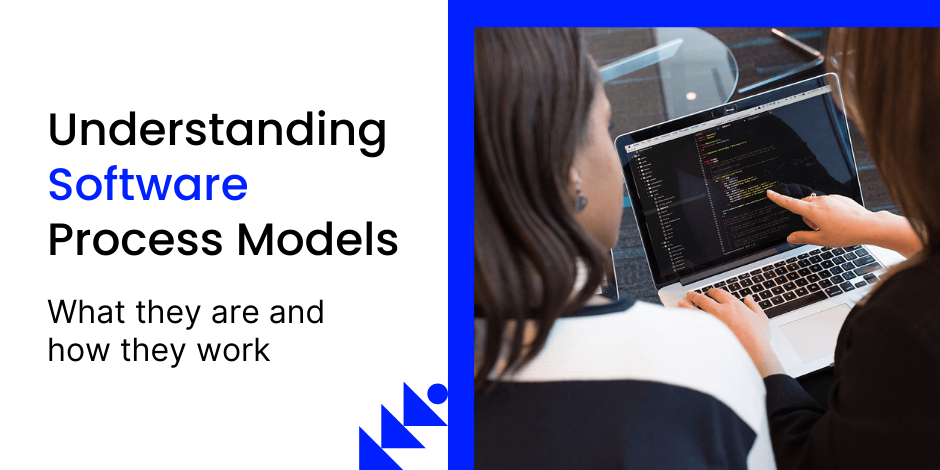Understanding Software Process Models: What They Are and How They Work

Stay Informed With Our Weekly Newsletter
Receive crucial updates on the ever-evolving landscape of technology and innovation.
Software process models are crucial in the field of software development. They provide a systematic approach to guide the software development lifecycle, ensuring the successful completion of projects.
We delve into the different aspects of software process models, their types, functioning, benefits, and how to choose the right model for specific projects.
Defining software process models

Before we delve deeper into software process models, let’s define them. Software process models are frameworks that define the sequence of activities, tasks, and deliverables required to develop high-quality software.
These models act as a roadmap, providing a step-by-step guide for software development teams.
Software process models are not just a set of rules to follow; they are dynamic and adaptable to different project requirements. They provide a structured approach to software development, ensuring that all necessary steps are taken to deliver a successful product.
When it comes to software development, there is no one-size-fits-all approach. Different projects have different requirements, and software process models help teams tailor their development process to meet those specific needs.
The role of software process models in software development
Process models play a crucial role in ensuring that projects are executed smoothly in software development. They provide all team members with a common language and understanding, promoting effective collaboration and communication.
Imagine a software development team without a process model. Each team member might have their own way of approaching the project, leading to confusion and inefficiency.
With a process model in place, everyone is on the same page, following a standardised set of procedures and guidelines.
Process models also help manage risks by identifying potential pitfalls early in the development lifecycle.
Teams can identify potential bottlenecks, dependencies, and risks by breaking down the software development process into manageable phases. This allows them to proactively address these issues, minimising the chances of project delays or failures.
Software process models also facilitate project planning and resource allocation.
By clearly understanding the activities and tasks involved in each phase of the development process, teams can estimate the time and resources required more accurately. This helps in setting realistic project timelines and budgets.
Key components of software process models
Software process models comprise various key components that are essential for successful software development. These components include:
- Requirements gathering and analysis
- Design and architecture
- Coding and implementation
- Testing and quality assurance
- Deployment and maintenance
Requirements gathering and analysis is the first phase of the software development process. It involves understanding and translating the client’s needs into clear and concise requirements.
This phase sets the foundation for the entire project, ensuring that the software meets the client’s expectations.
Design and architecture focus on creating a blueprint for the software.
It involves designing the overall structure, defining the modules and components, and establishing their relationships. This phase lays the groundwork for the coding and implementation phase.
Coding and implementation are where the actual development takes place. Developers write the code based on the design specifications, bringing the software to life.
This phase requires attention to detail and adherence to coding standards to ensure a high-quality end product.
Testing and quality assurance are crucial to ensure that the software meets the desired quality standards. This phase involves various testing techniques, such as unit testing, integration testing, and system testing, to identify and fix any bugs or issues.
Deployment and maintenance involve releasing the software to the end-users and providing ongoing support. This phase includes activities like installation, configuration, and user training.
Maintenance tasks, such as bug fixes, updates, and enhancements, are carried out to ensure the software remains functional and up-to-date.
By following these key components, software process models provide a structured approach to software development, ensuring that all necessary steps are taken to deliver a successful product.
Different types of software process models

When it comes to software development, several types of process models can be utilised. Each model is suited for different project requirements and teams, offering unique advantages and disadvantages. Let’s explore some of the popular software process models:
Waterfall model
The waterfall model is a linear, sequential approach that progresses strictly top-down.
It follows a structured flow, where each phase of the development cycle must be completed before progressing to the next. This model is ideal for projects with well-defined and stable requirements.
One of the key benefits of the waterfall model is its simplicity. The linear nature of the process makes it easy to understand and implement.
The clear documentation and well-defined milestones make it easier to manage and track progress.
However, the waterfall model has its limitations. Since it follows a strict sequence, any changes or modifications to the requirements can be challenging to accommodate.
The lack of flexibility can lead to delays and increased costs if changes are required later in the development cycle.
Agile model
The agile model, on the other hand, emphasises flexibility and adaptive planning. It promotes iterative development, allowing teams to deliver working software in frequent, short iterations.
This model is well-suited for projects with changing requirements and a need for quick responses to customer feedback.
One of the key principles of the agile model is collaboration. The development team works closely with the stakeholders, constantly seeking feedback and incorporating it into the development process.
This iterative approach allows continuous improvement and ensures that the final product meets customer expectations.
However, the agile model also has its challenges. The emphasis on flexibility and frequent iterations can sometimes lead to scope creep, where the project expands beyond its original boundaries.
Additionally, the lack of a strict plan can make it difficult to accurately estimate project timelines and costs.
Iterative model
The iterative model focuses on incremental development, where each iteration produces a working software component. This approach allows for early prototyping and testing, enabling feedback-driven improvements throughout development.
One of the key advantages of the iterative model is its ability to handle evolving requirements. The team can adapt to changes and incorporate feedback at each stage by breaking the development process into smaller iterations.
This flexibility ensures that the final product aligns with the customer’s evolving needs.
However, the iterative model also has its drawbacks. The constant need for feedback and improvements can sometimes lead to a longer development cycle.
Managing multiple iterations simultaneously can be challenging, requiring effective communication and coordination among team members.
The functioning of software process models
The stages of software process models
The software process model guides the software development lifecycle and generally consists of several stages or phases, which vary depending on the specific model used. However, common stages include:
- Requirements gathering and analysis
- Design and architecture
- Coding and implementation
- Testing and quality assurance
- Deployment and maintenance
The flow of tasks in software process models
Within each stage of a software process model, there are specific tasks and activities that need to be performed. These tasks flow from one stage to the next, with dependencies and inputs/outputs clearly defined.
A well-defined flow of tasks ensures that the software development process maintains its momentum and progresses smoothly.
Benefits of using software process models

Efficiency in software development
Process models significantly enhance efficiency by providing a structured approach to software development. They enable teams to streamline their workflows, minimising the risk of missed deadlines or overlapping tasks.
Moreover, process models help identify potential bottlenecks and areas for improvement, leading to greater productivity.
Quality assurance and risk management
Software process models facilitate robust quality assurance and risk management practices. These models ensure that software is thoroughly tested before deployment by defining specific checkpoints and validation processes.
Additionally, they enable teams to identify and mitigate risks early on, reducing the likelihood of costly errors or delays.
Choosing the right software process model
Factors to consider
When selecting a software process model for a project, several factors must be taken into account:
- Project size and complexity
- Stability of requirements
- Customer involvement and feedback
- Team size and expertise
- Schedule and time constraints
Tailoring models to specific projects
It is important to recognise that software process models are not one-size-fits-all. Teams must carefully evaluate their project requirements and tailor the model accordingly.
This may involve combining elements from different models or creating a customised approach that fits the project’s unique needs.
Conclusion
Understanding software process models is essential for successful software development. These models provide a structured approach, enabling teams to deliver high-quality software efficiently.
By selecting the appropriate model, teams can ensure that their projects progress smoothly, with effective risk management and quality assurance practices in place. So, next time you embark on a software development project, consider the right software process model to guide you towards success.
Whether you’re an IT professional or new to tech, the Software Engineering program at the Institute of Data is designed to give you hands-on experience in programming, web, and UI development. It’s a chance to learn from dedicated industry professionals, gain technical skills and boost your resume.
We also offer free career consultations with our local team if you’d like to discuss your options.




